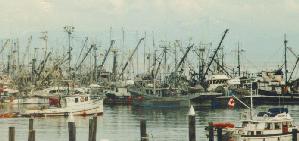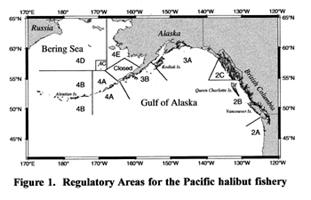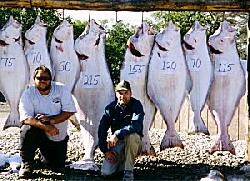June 27th, 1998
FRESH HALIBUT ANYONE? NOT FROM OUR SEAS
By Jackie Alan Giuliano, Ph.D.
This is the Year of the Ocean, we are told. And in the United States, the bounty from our
oceans that ends up in our stores and on our dinner tables is truly amazing. How could
there possible be anything wrong with our oceans - just look at any supermarket fish
counter. There is everything imaginable, just for the asking.
But the fact that virtually every market you visit in any city in the country will have an
abundance of fish is a powerful clue that we must be emptying our oceans. I don't eat
halibut - or any meat, fish, or dairy products. But many people do who are under the
impression that the fish they eat is "fresh caught" or "fresh frozen."
The reality, however, may shatter anyone's assumptions.
Much of the halibut consumed in the U.S. comes from Alaska. Thousands of commercial
fishing vessels are registered in Alaska to catch halibut. As with any other business in
the U.S., no one will be turned away. No one is told, "I'm sorry, you will have to
find something else to do, we have enough people fishing halibut." No potential
business owner is ever told that we have enough. The business ethic we practice in the
U.S., in fact, is that there is never "enough."

Fishing boats at Port Hardy, British Columbia, Canada from the Canadian Halibut
website.
Thousands of boats, and countless sportfishing vessels, are a tremendous drain on the
resources. All Alaska halibut would be gone in a very few months without the enactment of
a fishing season and fishing limits.
How long do you think the halibut season is? Well, it depends on where you want to fish.
In California, Oregon and Washington the season is limited to five 10-hour periods in
July, August, and September when a total of 169,000 pounds of halibut are allowed to be
caught.
Think about that. If you are ordering halibut at your favorite restaurant in June, if it
came from California, Oregon, or Washington, it may have been caught nearly a year
earlier! During these short 10-hour seasons, many boats with tens of thousands of pounds
of halibut on board are coming in at the same time, overloading processing plants. Fish
may sit on the dock for days waiting to be processed.  In the entire Pacific halibut
fishery, shown in the map here, 71 million pounds of halibut will be allowed to be taken
from March to November 1998 - except for California, Oregon and Washington where the short
seasons prevail. On June 12, 1998 alone, 216,675 pounds of halibut was expected to be
brought in by boats in these regions. In the entire Pacific halibut
fishery, shown in the map here, 71 million pounds of halibut will be allowed to be taken
from March to November 1998 - except for California, Oregon and Washington where the short
seasons prevail. On June 12, 1998 alone, 216,675 pounds of halibut was expected to be
brought in by boats in these regions.
Our oceans cannot sustain these fishing pressures, nor can our oceans sustain the toxic
impacts that the thousands of fishing boats have.
We have little solid information on the real state of ocean ecosystems. We understand very
little about the population dynamics of many fishes. Most of the data used by governmental
fish and game departments to determine the fishing limits and seasons is provided by the
fishing industry.
This kind of pressure on the seas has a multitide of other impacts. Sea lions and other
marine mammals that depend on the fish suffer from the reduced amount of their food.
Many non-target species, called bycatch, die in the fishers' nets. Millions of sea lions,
birds, and fish species other than the target species, say halibut, die in the nets and
become waste. There are regulations on the bycatch, but in the open sea it is impossible
to enforce these rules.
The amount of bycatch is staggering. From January 24 through June 6, 1998, the Pacific Cod
caught in the Bering Sea and Aleutian Islands was 156 million tons. Caught among those
millions of fish were unwanted halibut - 3,140,480 pounds of it. That's right, the halibut
that is gold to the halibut fishers is trash to the cod fishers. The halibut that was
trashed by the cod fishers in the first six months of this year amounted to 4 percent of
the total limit of halibut in the entire Pacific halibut fishery.

There is such danger in viewing our oceanic neighbors as just a food resource. This
view leaves no room for considering the complexities of the intricate web of life on our
planet and denies us the power and beauty of the connections between us all.
The pressure on life in the sea is triggered by the demand in the marketplace. The Earth
is an ocean planet and each of us can directly affect the life in the sea by examining our
consumer choices and making changes in our demands.
Maybe if we changed our demand from one of wanting plentiful halibut in the market to a
demand that halibut be healthy and vibrant in the ocean, our planetary health and energy
would increase dramatically. The halibut and cod would be grateful - and so would our
souls.
RESOURCES
1. Read the details of the 1998 halibut fishing regulations at http://www.iphc.washington.edu/PAGES/Publications/Regs/1998/RegsIntro.html
2. Further information on the allowed halibut catch is at http://www.iphc.washington.edu/pages/NewsReleases/1998/annmtg98.htm
3. Tour the Smithsonian Museum's Ocean exhibit at http://seawifs.gsfc.nasa.gov/OCEAN_PLANET/HTML/ocean_planet_overview.html
4. Remind yourself of the incredible amount of fish being taken from the seas by visiting http://www.iphc.washington.edu/PAGES/IPHC/Commercial/Canada/CanadaLandingReport.htm
for updates on the halibut catch.
5. Visit the Year of the Ocean web site at http://www.yoto98.noaa.gov/facts/resource.htm
and learn more about overfishing.
6. Jacques Cousteau, who died earlier this year at the age of 87, did more to help our
oceans than any single individual. Visit the Cousteau Society's web site at http://www.cousteau.org/AN/welcomeh.html
7. Learn about how do decrease the amount of animal products in your diet from Earthsave
at http://earthsave.org/intl/mission/index.htm
8. Find your Congressperson and e-mail them. If you know your Zip code, you can find them
at http://www.visi.com/juan/congress/ziptoit.html
and tell them you want our ocean resources managed for the future health of the planet,
not the immediate health of business.
9. Learn about the issues. Seek out books on the subject. A good source for used (and new)
books is Powell’s Bookstore in Portland, Oregon at http://www.powells.com/cgi-bin/associate?assoc_id=212
where you will find a wonderful alternative to the massive chain bookstores taking over
the market.
10. Visit the owlcam at http://members.aol.com/owlbox/nest98.htm
to see a family of owls living and raising their young. Remind yourself of the miraculous
cycles of life. Updated daily.
{Jackie Giuliano, Ph. D., can be found at the beach in Venice, California, looking at the
troubled ocean. He is a Professor of Environmental Studies for Antioch University, Los
Angeles, and the University of Phoenix Southern California Campuses. Please send your
thoughts, comments, and visions to him at jackie@deepteaching.com
and visit his web site at http://www.jps.net/jackieg} |
